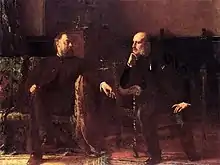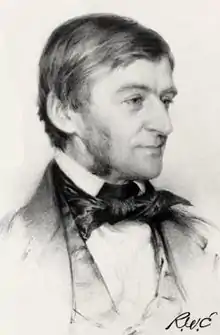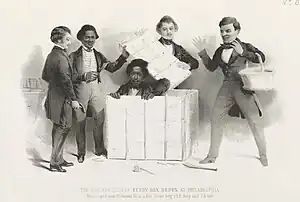Samuel W. Rowse
Samuel Worcester Rowse (January 29, 1822 – May 24, 1901) was an American illustrator, lithographer, and painter.[1] He was most famous for his drawings of Ralph Waldo Emerson and Henry David Thoreau. Rowse is also well known for his lithograph, The Resurrection of Henry Box Brown at Philadelphia.

Early life
Rowse was born in Bath, Maine on January 29, 1822.[2][3] He worked in Maine as an engraver.[4]
Works

In 1852, Rowse worked for a lithographer and then opened a studio in Boston, Massachusetts, due to the demand for his crayon (pastel) and charcoal portraits. He developed a reputation for his drawings of people in the news.[4][5] Rowse boarded with the family of Ralph Waldo Emerson in the summer of 1854, and while there sketched Henry David Thoreau, which was considered to be a good likeness by Sophia Thoreau. The drawing, which had hung in the Thoreau house, was donated to the Concord Free Public Library by Amos Bronson Alcott after he purchased the house in 1877.[6] In June 1858,[1] Rowse made a sketch of Emerson, considered by William James Stillman to be "the most masterly" depiction of him. The drawing is displayed in Emerson'a former home in Concord. Rowse is best known for these images.[6]

Copies of his lithograph of The Resurrection of Henry Box Brown at Philadelphia were used by anti-slavery activists prior to and during the American Civil War (1861–1865) to raise funds for the Underground Railroad and other anti-slavery campaigns. Henry Box Brown was a slave who escaped from Richmond, Virginia in 1849 by having himself shipped overland express to Philadelphia, Pennsylvania in a small crate, delivered to Passmore Williamson, Reverend James Miller McKim, and other members of the Pennsylvania Anti-Slavery Society. His journey took 27 hours and was considered a miracle of the improved private mail system.
In 1864 Rowse joined the Saturday Club, of which Emerson was a member.[6] Rowse went to London in 1872 with mathematician and philosopher Chauncey Wright. He met John Ruskin and American cultural critic, Charles Eliot Norton while there. He moved to New York City in 1880. Rowse is depicted in his friend, Eastman Johnson's painting of two men, The Funding Bill, which is in the Metropolitan Museum of Art's collection.[4]
He was commissioned to make portraits of James Russell Lowell, Nathaniel Hawthorne, Henry Wadsworth Longfellow.[6] and Frances Appleton Longfellow (1859), which is in the Longfellow Trust Collection.[7] Generally the portraits were drawings in black and white, and in crayon.[2] Other subjects were the family of Frederic Edwin Church,[8] Arthur Hugh Clough[9] and Howard Dwight.[10] Annie Adams Fields, wife of Boston publisher James T. Fields, sat for a black crayon drawing by Rowse and noted the artist was "eccentric but true and interesting".[11]
He made portraits of children, which exhibited at the galleries of M. Knoedler & Co. in January, 1902. A book was published that year entitled Ideal Children's Heads in Crayon and Oil.[12]
Rowse died in Morristown, New Jersey on May 24, 1901.[13]
References
- Ralph Waldo Emerson (1978). Journals and Miscellaneous Notebooks: 1854-1861. Harvard University Press. p. 204. ISBN 978-0-674-48477-1.
- Thomas William Herringshaw (1904). Herringshaw's Encyclopedia of American Biography of the Nineteenth Century: Accurate and Succinct Biographies of Famous Men and Women in All Walks of Life who are Or Have Been the Acknowledged Leaders of Life and Thought of the United States Since Its Formation ... American Publishers' Association. p. 806.
- Bowdoin College (1920). Report of the President. Bowdoin College. p. 49.
- Kevin J. Avery; Metropolitan Museum of Art (New York, N.Y.) (1 January 2002). American Drawings and Watercolors in the Metropolitan Museum of Art. Metropolitan Museum of Art. pp. 338–339. ISBN 978-1-58839-060-8.
- Katherine Sherwood Bonner McDowell (2000). A Sherwood Bonner Sampler, 1869-1884: What a Bright, Educated, Witty, Lively, Snappy Young Woman Can Say on a Variety of Topics. Univ. of Tennessee Press. pp. 66–. ISBN 978-1-57233-067-2.
- Tiffany K. Wayne (1 January 2009). Encyclopedia of Transcendentalism. Infobase (Publishing. pp. 242–243. ISBN 978-1-4381-0916-9.
- Bowdoin College (1920). Report of the President. Bowdoin College. p. vii.
- Carr, Gerald L. (1994). Frederic Edwin Church: Catalogue Raisonne of Works at Olana State Historic Site, Volume I. Cambridge: Cambridge University Press. p. 8. ISBN 978-0521385404.
- "Arthur Hugh Clough". National Portrait Gallery, London. Retrieved May 20, 2020.
- "From the Harvard Art Museums' collections, Capt. Howard Dwight (1837-1863)". Harvard Art Museums. Retrieved May 20, 2020.
- Gollin, Rita K. Annie Adams Fields: Woman of Letters. Amherst, MA: University of Massachusetts Press, 2002: 43. ISBN 978-1-55849-313-1
- S. W. Rowse (1902). Ideal Children's Heads in Crayon and Oil. New York: M. Knoedler & Co. OCLC 79734623.
- Pr, Oxford Univ (March 1, 2006). "Samuel Worcester Rowse". Benezit Dictionary of Artists. Oup USA. ISBN 978-0-19977-378-7.
Further reading
- Fielding, Mantle; Opitz, Glenn B.; Carr, James F. (compiler & publisher) (1965). Entry → "Rowse, Samuel Worcester" (1822–1901) in Mantle Fielding's Dictionary of American Painters, Sculptor's and Engravers – With Addendum. New York. Retrieved August 19, 2022 – via Internet Archive (Boston Public Library).
{{cite book}}: CS1 maint: location missing publisher (link) LCCN 65-27268; OCLC 704555087 (all editions), OCLC 560418490 (all editions), 920728594, & 1331580953
External links
![]() Media related to Samuel Worcester Rowse at Wikimedia Commons
Media related to Samuel Worcester Rowse at Wikimedia Commons
- Samuel Rowse's works, Smithsonian Institution Research Information System